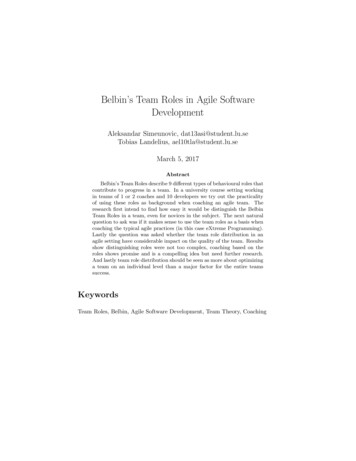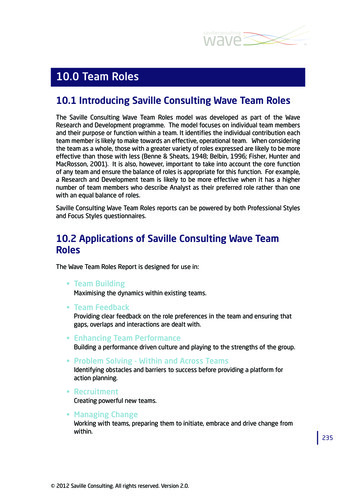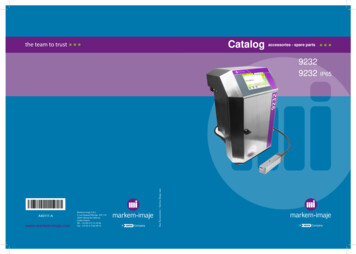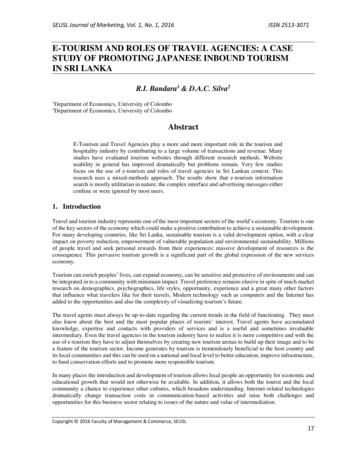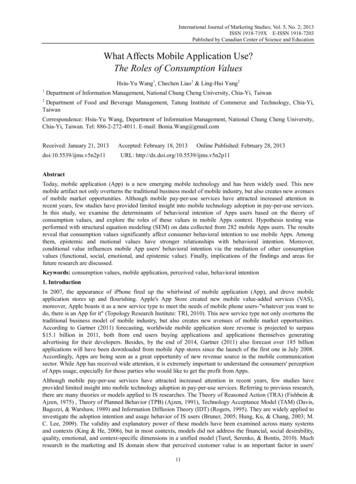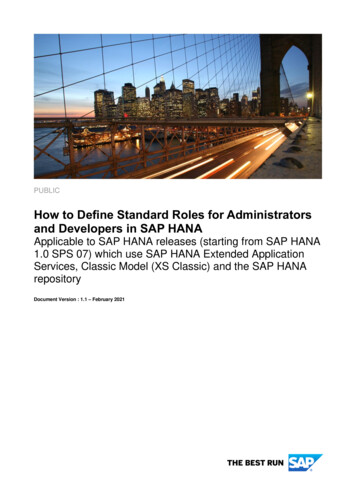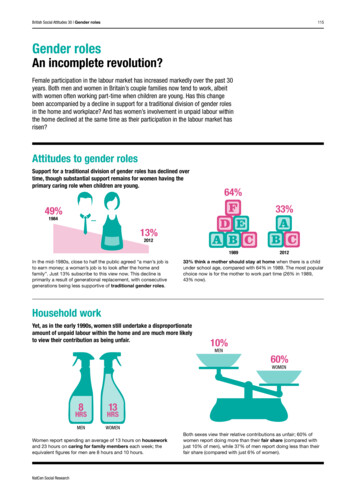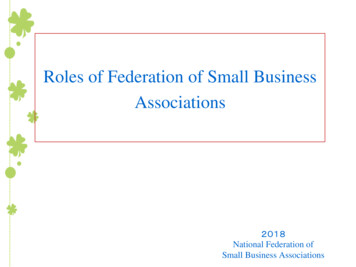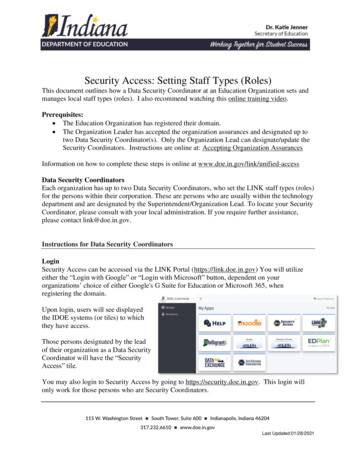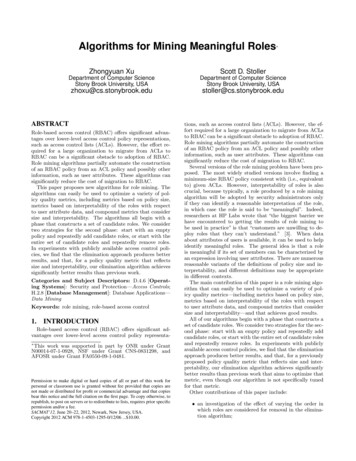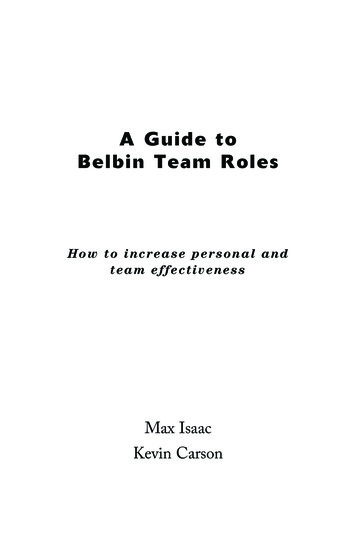
Transcription
A Guide toBe lbin Team Rol e sH o w t o i n c re a s e p e rs onal andt e a m e f f e c t i v e n e ssMax IsaacKevin Carson
From 3Circle Partners3Circle Partners works with businesses that are looking toenhance value by driving better performance and/or maximizing their investments in improvement programs. Ourcustomized approach will accelerate your organization’sperformance through strong leadership and strategy, solidinternal processes for superior execution, and effectiveinteractions.AcknowledgmentsThanks to Meredith Belbin for his support over the yearsand allowing us to cite his material. We would also like tothank Sue Reynard and Carole Johnson for their invaluablecontributions to this book. 2005, 2012 3Circle Partners.All Rights Reserved.Reproduction in whole or in part prohibited except withprior written permission.www.3CirclePartners.com877-333-3606 or 416-483-7380Published by Bridge PublishingISBN 978-0-9862956-7-6
T able of Conte nt sIntroduction. 1Chapter 1 Belbin’s Research:Discovering team roles. 5Phase 1: Teams of high intelligence.5Phase 2: Teams of like personalities.6Phase 3: Searching for balance.7Validation of the Belbin Model. 12Chapter 2 Applications of Belbin’s Insights. 15Developing Team Role Reports. 15Team Applications. 18Roles needed during project phases. 19Interpreting Balance and Imbalance. 20Individual Applications. 28Does Belbin knowledge reallymake a difference?. 32Conclusion. 36Appendix 1: Team Roles Quick Reference Guide. 37Plant. 38Monitor Evaluator. 40Specialist. 42Shaper. 44Implementer. 46Completer Finisher. 48Resource Investigator. 50Team Worker. 52Coordinator. 54
ivTa b l e o f C o n t e n t sAppendix 2: Interpreting a Belbin ReportPage 3: Analysis of Your Team Role Composition. 58Page 4: Team Role Overview. 60Page 5: Comparing Self and Observer Perceptions. 62Page 6: Your Team Role Preferences. 64Page 7: Observed Team Role Strengthsand Weaknesses. 66Page 8: List of Observer Responses. 68Page 9: Team Role Feedback. 70
Introductio nIrene, Carlos, Sandy, and Roger have beenbrought together in a development team chargedwith designing a new mortgage service for theirbank. Irene, as the bank manager, is servingas the team leader and has selected the othermembers. She picked Carlos because he knowsthe most about mortgages, Sandy because she isan experienced loan officer, and Roger becausehe was involved in several service design projectsin the past.Everything goes well for about a month. Theteam has lively discussions around setting goalsand holds very productive meetings with customers to identify critical needs. But then things goawry. Irene, Carlos, and Roger have come up withseveral potential service designs, but can’t seem tofinalize the definition. They keep thinking of moreand more different options to build into the service.Sandy, on the other hand, sees time slipping by,but doesn’t feel like she can stand up to the otherteam members to enforce deadlines.If your company is like this bank, the selection of teammembers is a straightforward process conducted by a manager or executive. Like Irene, your managers or executiveschoose teams based on common criteria such as subjectmatter expertise, possession of relevant skills or knowl-
2A G u i d e t o B e l b i n Te a m R o l e sedge, availability, a personal stake in the outcome of theproject, and position within the company.But is that really the best approach? You’ve probably seenteams like this one that perform very well for a while butthen get bogged down—or ones that never seem to get outof the project definition phase. The failure of many teamsmakes it clear that perhaps we need to consider whethersomething else is going on; that perhaps we need to consider whether a given collection of individuals will work welltogether.In fact, this latter approach does provide insights into whatexactly makes a team effective. The study of team composition began in the 1970s when Meredith Belbin, a researcher in the United Kingdom, spent nine years intensivelyresearching the factors that made teams either effectiveor ineffective. The outcome of this research is his seminalwork on Team Role Theory, which explains why it is themix of different team skills within the team that is the primary determinant of team effectiveness. In research trials,Belbin and his colleagues were able to accurately predictwhich teams of executives would do well in managementsimulations and which would falter. The findings have sincebeen applied worldwide to real-life business situations.For our purposes here, the critical outcome from Belbin’sresearch is that the criteria his research revealed as beingcrucial to team success bear little to no resemblance tostandard team-selection criteria, such as those listed above.More importantly, while the criteria in widespread use havelittle to no correlation to team success, Belbin’s Team Role
Introduction3Theory has great predictive power. And it shares the virtueof being relatively easy to implement in the real world.In this section, we will quickly recap Belbin’s research. Wewill then explore its application to you as an individual andto your teams. We’ll also explore the experience of Irene’smortgage team in more depth. But first some background.
CHAPTER 1Be lbin’s Res ea r ch:Discovering T e a mRolesBelbin’s research was a cooperative effort between theIndustrial Training Research Unit based in Cambridgeand Henley College, the oldest business school in the U.K.Henley’s approach to training was to form groups of ten oreleven managers into what they called syndicates.These syndicates were carefully selected so that there wasa balance of backgrounds and experience in the group.The use of syndicates in learning led to a growing interestin management teams. Henley had noticed that some syndicates did better than others. This became the subject ofmuch debate. This is where Meredith Belbin came into thepicture. A research initiative was established to undertake astudy of what made some teams more successful than others. Over a period of nine years, Belbin and his colleagues atHenley studied participants assigned to small teams whichcompeted against each other in management simulations.
6A G u i d e t o B e l b i n Te a m R o l e sPhase 1: Teams of High IntelligenceAn early hypothesis was that the success of these teamswould be highly correlated to the individual excellence ofteam members (that is, the teams with the smartest peoplewould finish highest). As a matter of course, Belbin administered standardized intelligence tests to the students. Thenhe intentionally put those with the highest scores togetherin teams (dubbed “Apollo” teams after the American spaceprogram’s rocket scientists).It may not surprise you that when the results of the simulations were analyzed, the Apollo teams typically finishedclose to last or dead last! They were difficult to manage,prone to destructive and unresolved debates, and oftenmore internally competitive than collaborative. In manycases, one individual’s actions would intentionally or unintentionally undermine those of another team member.There were a few successful Apollo teams. Like all Apolloteams, their members were highly intelligent, but the peopleon the successful Apollo teams tended to be less assertive.The team also had a chairperson (we’d call that person ateam leader nowadays) who was able to corral the talentsof the team members and also counteract any tendencyfor members to sit back and be passive. In addition, thesuccessful Apollo teams had explicit conversations abouthow to compensate for such a uniformly intellectual group.With these factors and strategies in place, they managed todevelop and execute effective strategies without devolvinginto internal squabbling.
1: Belbin’s Research7Phase 2: Teams of like orientationsThe rare successful exceptions to the Apollo patternbecame the basis for a shift away from purely intellect-based hypotheses towards ones that incorporatedmore behavioral elements. As part of his research, Belbinadministered personality tests in addition to intelligencetests. He then formed “pure teams” of individuals with likepersonalities to see if there was any advantage to certainpersonality profiles.While there were slight performance differences among thevarious pure teams, no personality type was found to beuniversally effective for a homogeneous team. Rather, theirpersonalities tended to make them well-suited to certaintypes of tasks and ill-suited to others. During the multiday management simulation, each of the pure teams’ weakpoints were exposed at some point, and overall the teamswere deemed to be less-than-optimal performers.Phase 3: Searching for balanceThe focus of Belbin’s investigation now turned to achievingbalanced teams that could combine the best attributes ofthe different “pure teams” all of whom excelled at sometasks and struggled with others. Here the challenge wasto isolate which attributes significantly contributed toenhanced team performance.Because the results of the teams were measurable and thecomposition of team members was known from the stand-
8A G u i d e t o B e l b i n Te a m R o l e spoint of individual test scores on personality, intelligence,and other tests, the researchers were able to analyze whatcombinations were present in successful teams and absentin failed teams. As the study progressed, Belbin and histeam developed descriptions for nine different team roles,skills and contributions that proved useful on teams. Hereis a quick recap of what Belbin discovered about team roles:One of the first critical attributes to emerge in the researchwas creativity, which was fulfilled by two distinct types ofcontributions: The creative contribution to the team came to becalled the Plant role by Belbin because he intentionally “planted” people with this skill into teams. Whenthese individuals were given the opportunity by theteam to be creative, the team’s performance consistently improved. When the Plant role was suppressedor overlooked, the team failed to harness the power oftheir creativity and performance suffered. A second category associated with new ideas is theResource Investigator role. The differentiation isthat while the Plant role relies on internal thinking tocome up with ideas, the people who play the ResourceInvestigator role well are adept at using other people(often outside the team) to collect new ideas or discover opportunities that the team could incorporateinto their strategies and actions.Whether or not a team is able to capture these ideas seemsto hinge on how the team is managed by its leader or chairperson. Again, Belbin found this team need being filled intwo very different ways: The more successful chairperson had a specific setof attributes that were later embodied in a team role
1: Belbin’s Research9called Coordinator. These individuals are seen tobe trusting and accepting of others, dominant, andcommitted to goals, as well as calm in a crisis. Theseattributes allow them to guide and facilitate the groupeffectively, as well as to orchestrate the assignment oftasks to the best-suited individuals. Another role that emerged during this phase, that ofMonitor Evaluator, proved to be a vital contributorto team success. People with this capability oftenare serious-minded and largely immune to infectious enthusiasm. Having the Monitor Evaluator rolewell-executed enables discovery of hidden flaws inan argument, allowing others to change their mindsbased on logic and reasoning.Another key role that emerged was the Implementer, people who made sure that things got done. The Implementerrole contribution is to be practical, realistic, and structured,ensuring that necessary tasks are performed. It is disciplined, orderly, and skilled at planning. Its presence on ateam ensured that decisions would be turned into results.Another style of leadership that Belbin identified only afterhis research became more widely known has been dubbedShaper, a role that is in many ways the opposite of the collaborative Coordinator role.The contribution of the Shaper role is to bring energy to theteam, challenge thinking, and stimulate action. Sometimes,this can be seen as argumentative and pushy. The presenceof decidedly different working styles in a team inevitablyleads to interpersonal conflicts, in som
03.06.2019 · 8 A Guide to Belbin Team Roles point of individual test scores on personality, intelligence, and other tests, the researchers were able to analyze what combinations were present in successful teams and absent in failed teams. As the study progressed, Belbin and his team developed descriptions for nine different team roles,
